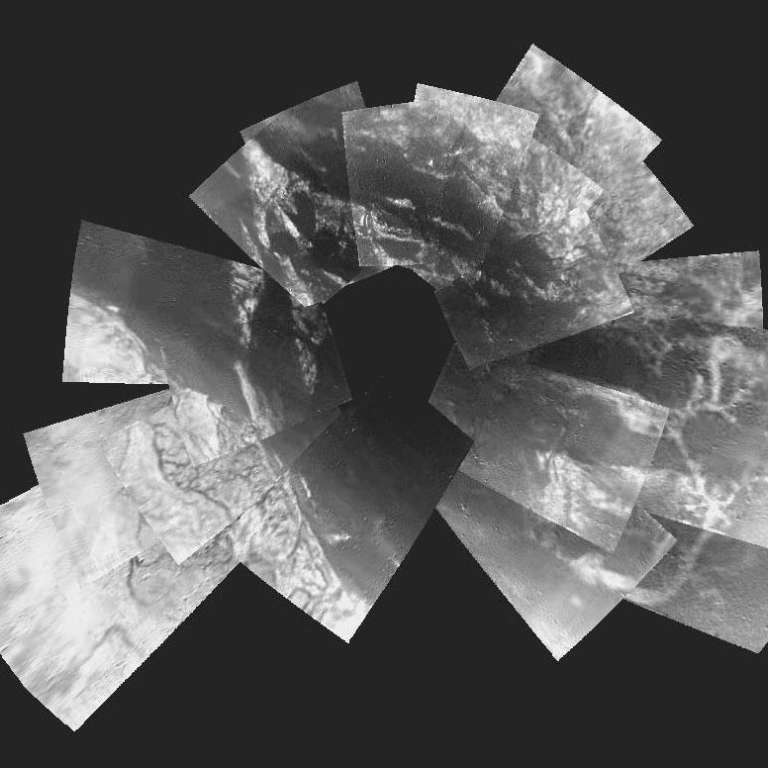All
All
Stories, updates, insights, and original analysis from The Planetary Society.
Spirit Suffers "Serious Anomaly," But Continues 'Beeping' Home
Something is wrong with Spirit, but what exactly it is -- and just how serious it is -- the Mars Exploration Rover team isn't sure.
Titan: Arizona in an Icebox?
A week after Huygens' descent, the emerging picture of the surface of that smoggy world is of an arid, icy desert, where periodic storms of methane rain create transient rivers that wash sooty soil from icy highlands out to short-lived pools and lakes. The pools dry up -- perhaps sinking into a sandy soil of glass-like water ice -- and the Titanian desert waits for another methane storm.
Spirit Discovers Surprises in Martian Soil, but Earth Weather Blocks Commands to Continue Work
Spirit got off to a running start this week, using three of the four instruments on her robotic arm to study a patch of Martian soil, and the football-sized rock Adirondack.
Spirit Ventures Out to First Target
Spirit ventured out yesterday, driving nearly 10 feet (about 3 meters) to its first target -- a football-sized rock that scientists have dubbed Adirondack. Meanwhile, Spirit's twin, Opportunity, successfully completed its first trajectory correction maneuver (TCM) in four months.
Spirit Extends Arm and Takes First Close-Up Images of Martian Soil
Spirit has extended her robotic arm for the first time to examine a patch of fine-grained Martian soil, and joined forces with the European Space Agency's Mars Express to successfully conduct the first-ever, international, coordinated observation of the planet's atmosphere.
Spirit Hits the -- Martian -- Road!
Spirit gets 6 wheels on soil. For some of the team members, this was the real landing.
Let's Roll: Spirit Poised to Cruise onto Martian Surface
Spirit is ready to roll.
Spirit Begins Maneuver to Roll onto Surface; Mars Rover will "Head for the Hills"
As Earthlings slept last night, Spirit completed the first part of a three-part maneuver that will take her down the ramp and onto the Martian surface early Thursday morning Earth time.
Mars Rover Spirit Sends First 360-Degree Color Panorama 'Postcard' and Prepares to Roll onto Martian Surface
As Spirit slept soundly after another near-perfect day of picture taking, science gathering, and data relays from Mars, NASA released the first color 360-degree panorama postcard it sent home.
Spirit Set to Roll Off Lander Thursday
Spirit is up -- standing at full height on all six wheels -- and is ready to roll off the lander heading west by northwest, probably sometime early Thursday morning Earth time, according to the latest plan.
Spirit Returns More "Exquisite" Data, Inspires New Generation of Space Explorers
Spirit continues to return
Spirit: A Star is Born, A Space Agency and A Nation Are Lifted
If a Hollywood screenwriter had crafted the scenes for the last few days of the Spirit Mission Team at JPL as they really happened -- success after success, triumphant image after triumph he or she would be out of a job.
Spirit Spends First Full Days on Mars; Scientists Report "More Good News"
With additional data due later today and early tomorrow morning, the mission team is hoping to receive and piece together the first color picture perfect panoramic postcard -- from the PanCam, a high resolution stereo vision camera -- for the briefing tomorrow.
Mars Exploration Rovers Update: Spirit Lands on Red Planet, Returns First Images
Spirit -- NASA's first Mars Exploration Rover -- survived the 'six minutes of terror' entering and descending through the atmosphere to land safely -- and upright -- in Gusev Crater on the Red Planet. Just two hours after the confirmation signal of the landing, the first engineering data and images began streaming into the MER Mission Control at the Jet Propulsion Laboratory (JPL), where Spirit and her twin, Opportunity were built.
Mars Rover 'Alive and Well' Returning More Images
Spirit spent a quiet, cold night in Gusev Crater, and woke up to return streams of new data, including more black and white 'postcards' from Mars.
NASA Begins Countdown to Spirit's Arrival on Mars
Spirit – the first of NASA's two robot geologists en route to the red Planet -- is “in “excellent” health, NASA and JPL scientists reported at a news briefing at JPL this afternoon, and the countdown to touch down on the Red Planet has begun.
No Icecaps at the Lunar Poles
New observations reported this week in the journal Nature have cast doubt on the theory that thick deposits of ground ice lie conveniently close to the surface in permanently shadowed crater floors at the lunar poles.
Researchers Discover Lakes on Titan
Recent radar observations of Saturn’s moon Titan have produced the first direct evidence that the second largest moon in the solar system may be hiding pools of liquid hydrocarbons underneath its smoggy atmosphere.
New and Improved SETI@home will Form the Backbone of Distributed Computing Network
SETI@home and BOINC are gradually converging, and the benefits for both are substantial. While SETI@home enjoys the increased flexibility of the BOINC platform, it brings to BOINC something of inestimable value to a distributed computing project: millions of SETI@home users, willing to use their computers' processing power for the advancement of scientific research.
Analyzing the Reobservations
SETI@home chief scientist Dan Werthimer and his team went back to Arecibo to reobserve the most promising candidate signals detected by the project so far. Unlike most of the year, when SETI@home piggy-backs on the regular operations of the telescope, this time the Werthimer's crew had the full use of the resources of the giant dish.


 Explore Worlds
Explore Worlds Find Life
Find Life Defend Earth
Defend Earth


 Sun
Sun Mercury
Mercury Venus
Venus Earth
Earth Mars
Mars Jupiter
Jupiter Saturn
Saturn Uranus
Uranus Neptune
Neptune Small Bodies
Small Bodies



